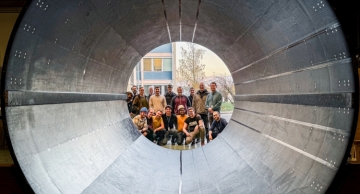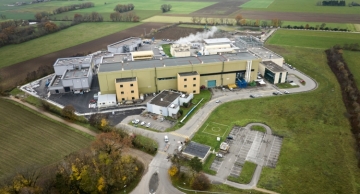After an eight-week journey, the first HGCAL absorber structure (CE-H1) was delivered to CERN and is ready to be assembled, just 100 metres above where the detector will eventually be located.
Seventeen enormous boxes were delivered at the CMS…
News
|
nstathak |
Detector
|
sohurst |
Detector
The increase in data processing capabilities means that CMS is one step closer to being ready for Run 4.
The new Data Acquisition (DAQ) room is a state-of-the-art server room, essential for the Hi-Lumi phase of the detector and beyond. New server…
|
sohurst |
Detector
New BRIL subsystems illuminate CMS’s path through Run 3
After many months of meticulous preparations, new BRIL subsystems were installed in mid-January. The intervention will ensure that CMS can continue to achieve world leading accuracy in its…
|
sohurst |
Detector
The TBPS Rings are in production, offering an innovative design to incline sensors toward the LHC beam and maximise coverage. They are the first support structures in production for the new Tracker!
As part of the CMS Hi-Lumi Tracker, construction…
|
sohurst |
Detector
The first of the improved Resistive Plate Chambers for Hi-Lumi CMS were installed in record time during the LHC winter break.
The RPC Hi-Lumi CMS Project reached an important milestone at the start of 2025 by delivering the first half of its final…
|
sohurst |
Detector
CERN and CMS engineers and technicians have installed the first two of nine required next-generation carbon dioxide (CO2) cooling plants in the underground Service Cavern of the CMS experiment in Cessy, France, as well as two of the accumulators.…
|
nstathak |
Detector
The heavy ion Run has just concluded, marking the start of the extended year-end technical stop (EYETS). Reflecting on 2024, this year’s LHC Run exceeded expectations, delivering the highest accumulated data volume to date. In alignment with this…
|
sohurst |
Detector
Above: Part of the BTST team during the unboxing of the tube. (Image: Noor Abduljalil J Abdulla)
In a massive step toward CMS’ High-Luminosity era detector, a key component of the build has arrived at the CERN laboratories.
CMS has received a…
|
sohurst |
Detector
CMS develops and deploys a new machine-learning technique based on neural networks that is able to spot existing and developing anomalies in the functioning of the detector.
In the quest to uncover the fundamental particles and forces of nature, one…
|
sohurst |
Detector
How to manage large amounts of data without losing any interesting ones? The selection of data concerning particle collisions in the LHC is critical since it will determine all the resulting analyses. This is the decisive work of a novel scouting…
|
sohurst |
Detector
The first wafers of the CMS Read Out Chip (CROC) for the High Luminosity Pixel detector have been produced and tested, marking a major milestone for the next generation CMS Tracker.
Each silicon wafer contains 136 chips that are built to withstand…
|
sohurst |
Detector
How an evacuation of the CMS experimental cavern has provided invaluable human behaviour data to improve the emergency preparedness for complex underground facilities.
CERN and CMS strive for excellence in safety matters, with a commitment to…











